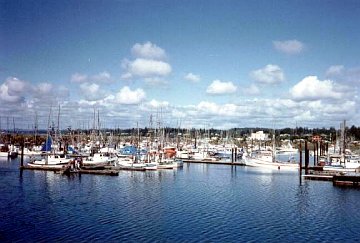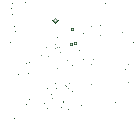~~* The Singing Falls Stream Restoration Project *~~
 ϕ
ϕ
~~*Safe Harbors for Salmon*~~
We know them as harbors and marina sites, boating areas and clamming grounds. But they are also estuaries--the places where rivers meet the sea and freshwater mingles with salt--and they are vital to the survival of our salmon runs.
From a fish's perspective, estuaries are a mosaic of habitats. At one time or another, a salmon may use saltmarshes, fresh water marshes further upstream, rocky areas, and eelgrass beds. The abundant food sources in these naturally productive areas, as well as the wealth of food produced in the mud flats, are critical to salmon as they build up strength before entering the ocean. The loss of any of these habitat types can severely degrade an estuary as a refuge or feeding grounds for salmon (not to mention many other estuarine inhabitants).

Coos Bay harbor fishing fleet
Not only do salmon use different parts of the estuary, but different species of salmon use estuaries in different ways. Pink salmon spawn in the lower reaches of rivers; the just-hatched young (“fry”) move downstream immediately, often doing most of their growing in the estuary. In many river systems, chum salmon follow a similar pattern.
Both coho and chinook salmon arrive in the estuaries at a later point in their life cycles, having matured for a number of months (coastal chinook) or a year (coho and upper Columbia Basin chinook) in the stream. Chinook may remain in the estuary up to a half year, whereas coho usually spend only a few weeks. In either case, though, the feeding that the young fish (known at this stage as “smolts”) do in the estuary is critical to their fitness to survive in the open ocean. Estuaries are also the places where the young salmon go through the internal transformation that enables them to switch from living in freshwater to living in full-strength seawater. Many salmon also pause in the estuaries on their return from the ocean as adults, to do their final feeding before pushing upriver.
Because estuaries are the lower-most point of rivers, they are affected by everything that happens upstream. Toxins and sewage in the water-- not only what may be dumped directly into the bay, but anything entering the river at any point in its length-- can adversely affect fish. Pollutants can come from sewage treatment plants, industrial sources, marinas, or run-off of chemicals and silt from homes, farms and forests. Removal of vegetation in a river's watershed, though timber-cutting, agricultural clearance, or development actions can greatly alter the duration and timing of peak water flows. This can disrupt the life cycles of creatures in the estuary and effect its overall productivity.
Perhaps most devastating is the loss of fringing marshes, which provide shelter and prey to young fish. More than 90% of California's coastal wetlands have been lost to development; coastal wetland loss in Oregon and Washington is estimated to be about 50-60%.
There are a number of things that salmon-lovers (and bay lovers) can do to protect estuarine habitat:
Support strong legislation protecting clean water and wetlands.
Participate in cleaning up litter around the shorelines of bays (picking up litter along streams and rivers will help, too).
If you own a boat, you can make a real difference in may ways: Make sure to have a trash container aboard you boat and prevent litter from being blown overboard; work to prevent oil spills and gas leakage (patronize marinas that use nozzles with automatic fuel shut-off nozzles and which provide oil recycling ); use an oil absorbent pad in you bilge so oil tainted water isn't discharged; do vessel maintenance and painting in dry dock and sweep up paint chips and other debris afterward.
Join a watershed group if one exists where you live. Those in the vicinity of Puget Sound, Tillamook Bay (Ore.) or San Francisco Bay might consider becoming involved with the National Estuary Program, which has projects underway on each of those water bodies.
For more information on what you can do to help salmon recovery efforts in the Pacific Northwest or to find contacts for groups in your area working to help restore salmon, please write the Pacific States Marine Fisheries Commission, 45 Se 82nd Dr., Suite 100, Gladstone, OR 97027-2522.
Stream Index
top






